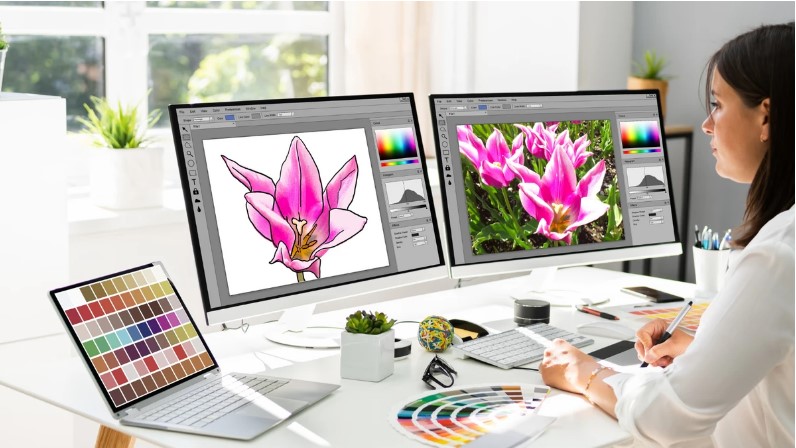If you work with printed merchandise, fabric, apparel decoration, or engraving, then you already know how important high-quality artwork is. This is exactly where professional Vector Art Services come in. Clean vectors are the foundation of sharp prints, smooth lines, and crisp final products no matter whether you’re doing DTG printing, screen printing, sublimation, laser cutting, or engraving. The truth is simple: without proper vector artwork, even the best machines struggle to produce quality results.
In this guide, we’ll break down what vector art is, why it matters, how it helps across different printing and engraving methods, and the top tips to make your designs look polished and production-ready.
What Is Vector Art & Why Is It So Important?
Vector art is digital artwork made using mathematical curves and points rather than pixels.
This means:
- It stays sharp at any size.
- It doesn’t blur or pixelate, even when enlarged.
- It’s easy to edit and recolor.
- It’s compatible with almost all print and engraving machines.
Raster images (JPG, PNG, BMP) lose clarity when scaled, but vector files (AI, EPS, SVG, PDF) stay smooth and sharp.
So, when a client sends a rough screenshot or low-resolution image, you can’t simply print it as-is. It needs to be manually recreated into a vector for professional results.
That’s why vector conversion is an essential step in every printing workflow.
Why Businesses Need Professional Vector Art
Whether you run a sign shop, a screen printing studio, or a promotional branding company, clean vector files help streamline your entire production.
Benefits include:
- Faster printing
- Better color accuracy
- Smooth outlines and professional finishes
- Precise engraving cuts
- Easy scaling for small or large designs
- Reduced file errors and machine issues
Simply put, vector art saves time and produces cleaner results no matter the industry.
Vector Art Services for DTG, Screen Print & Engraving
Let’s break down how vector art supports each method and why it’s essential for top-notch output.
1. Vector Art for DTG (Direct-to-Garment) Printing
DTG printing produces detailed, colorful artwork directly onto fabric. Even though DTG printers can technically work with high-resolution raster images, clean vectors still make everything smoother.
Why vectors matter for DTG:
- You get clean and crisp lines
- Colors separate accurately
- Edge quality improves
- Transparent backgrounds become flawless
- Scaling becomes easy for multiple shirt sizes
DTG also requires precise shapes for color layering, and vector files are perfect for achieving that.
Best use cases:
- Logo printing on t-shirts
- Simple artwork with solid colors
- Small branding on sleeves or pockets
- Kids’ clothing designs
- Text-based designs
2. Vector Art for Screen Printing
Screen printing commonly requires color separation, and vector art makes this much easier.
Why screen printers love vectors:
- Easy Pantone matching
- Smooth lines and curves
- Hassle-free separation of each color layer
- Crisp printing on any fabric
- Perfect for single-color and multi-color jobs
Most screen printing shops prefer vector files because they offer precision and consistency especially for high-volume orders.
Where vectors excel in screen printing:
- Team jerseys
- Corporate uniforms
- Promotional merch
- Hoodies and sweatshirts
- Bulk t-shirt orders
- Simple or multi-color logos
If you’ve ever seen a screen printer struggle with a blurry JPG logo, you already know why clean vector art is essential.
3. Vector Art for Engraving & Laser Cutting
Laser engravers rely heavily on vector paths to determine where the machine cuts or engraves.
Why engraving requires vector files:
- Clear cut lines without distortion
- Perfect scaling for any object
- Smooth paths for engraving tools
- Reduced burn marks or rough edges
- High precision for detailed designs
Best engraving applications for vector art:
- Wooden signs
- Metal plates
- Gift engraving
- Jewelry engraving
- Custom awards
- Leather work
- Acrylic cutting
Without vector clarity, engraving machines can misread paths, leaving uneven cuts or jagged engravings.
Types of Vector Art Services You May Need
Professional vector services cover a wide range of tasks, depending on your needs. Here are the most common types:
1. Raster to Vector Conversion
This is the most requested service. It involves recreating pixel-based images into clean vector artwork.
Great for:
- Low-resolution logos
- Blurry images
- Screenshots
- Old printed designs
- Pixelated clipart
A skilled artist manually redraws your artwork to match the original—sharper, cleaner, and print-ready.
2. Vector Redrawing
Some files need more than conversion—they need rebuilding.
Useful when:
- The artwork is too complex
- Colors or shapes are unclear
- It needs a more polished look
- You need resizing or restructuring
- You want a modern, cleaner version of an old design
Redrawing brings old or unclear artwork back to life.
3. Vector Color Separation
Especially important for screen printers, this service breaks artwork into individual color layers.
Results include:
- Perfect color layering
- Smooth prints
- Cleaner registration
- Easier production setup
Pantone separation is also available when exact color matching is needed.
4. Logo Vectorization
Logos need to be sharp for all uses web, print, apparel, signage, vehicles, etc.
Vectorized logos allow:
- Easy scaling
- Color flexibility
- Clean branding
- Usage on any medium from banners to business cards
Every business should have a vector version of its logo.
How Vector Art Helps Your Workflow
No matter what kind of business you run, vector art improves your efficiency.
Here’s how:
- Machines operate faster with clean files
- You avoid delays caused by low-quality images
- Your customers get professional results
- You spend less time fixing poor artwork
- Your final products look polished and consistent
For printing businesses, time is money and vectors save both.
Tips for Getting the Best Vector Art Results
Here are some simple but effective tips that guarantee high-quality vector artwork every time:
1. Provide the Best Possible Original File
Even if it’s low-resolution, send the clearest version you have.
2. Decide the Final Size in Advance
Bigger prints may need more detail. Smaller prints may need simplified shapes.
3. Avoid Too Many Gradients
Some printing methods prefer solid colors or minimal shading.
4. Check Font Legibility
Thin fonts or small text may not print or engrave well.
5. Choose Simple Color Palettes
Fewer colors = easier printing and lower production cost.
6. Make Sure the Artwork Matches the Product
Engraving needs thicker lines. DTG can handle more detail. Screen printing needs smooth separations.
Industries That Rely on Vector Art Services
Vector files are used across many fields:
- Screen printing companies
- DTG print shops
- Promotional product makers
- Embroidery digitizing companies
- Laser engraving businesses
- Sign boards & banners
- Vehicle graphics
- Business branding
- Apparel manufacturers
Wherever artwork is needed, vectors play a key role.
Final Thoughts
Vector art is the backbone of clean, scalable, and professional printing and engraving. Whether you’re working with DTG printing, screen printing, laser engraving, or any customized merchandise, having high-quality vector artwork ensures your final product looks accurate, sharp, and impressive.
If you want your designs converted into crisp, production-ready vectors, brands like Absolute Digitizer provide reliable and professional vector art services that help you deliver flawless results every time.



